Boraras maculatus
Dwarf Rasbora
SynonymsTop ↑
Rasbora maculata Duncker, 1904
Etymology
Boraras: anagram of the generic name Rasbora, in reference to the reversed ratio of abdominal and caudal vertebrae in this genus.
maculatus: from the Latin maculatus, meaning ‘spotted’.
Classification
Order: Cypriniformes Family: Cyprinidae
Distribution
Described from Bandar Maharani, now more often referred to as Muar, district in Johor state, southern Peninsular Malaysia and distributed throughout the country with range extending into southern (peninsular) Thailand, eastern Sumatra, Singapore and the island of Bintan in Riau Islands province, Indonesia.
The full type locality is ‘Bukit Terah, Bandar Maharani [= Muar], Johore, Malaysia’.
Colour pattern tends to vary somewhat depending on population with some forms exhibiting more intense red colouration than others, for example. Some typical variations can be seen in the images accompanying this profile.
Habitat
Inhabits black water streams and rivers associated with ancient forest peat swamps. The water is stained brown due to the release of tannins and other chemicals released by decomposing organic matter and the substrate scattered with fallen leaves, twigs and branches.
Such environments characteristically contain very soft (negligible hardness), acidic (pH as low as 4.0) water and are often dimly-lit due to the forest canopy above.
Across much of Southeast Asia these biotopes are under serious threat from rubber/palm oil plantations, building developments and other human activities.
Maximum Standard Length
20 – 25 mm.
Aquarium SizeTop ↑
Though small it still needs space to swim and dominant males will form temporary territories when spawning so a group is best kept in an aquarium with base dimensions of at least 45 ∗ 30 cm.
Maintenance
Best kept in a densely-planted aquarium and is an excellent choice for the carefully-aquascaped set-up. The addition of some floating plants and roots or branches to diffuse the light entering also seems to be appreciated and adds a more natural feel.
Filtration does not need to be particularly strong as it mostly hails from sluggish waters and may struggle if there is a fast current.
To see it at its best a biotope-style set-up can also make an interesting project. A soft, sandy substrate is probably the best choice to which can be added a few roots and branches, placed in such a way that plenty of shady spots are formed.
The addition of dried leaf litter further emphasises the natural feel and encourage growth of microbe colonies as decomposition occurs. These tiny creatures can provide a valuable secondary food source for fry whilst the tannins and other chemicals released by the decaying leaves are thought to be beneficial for blackwater fish species. Leaves can be left in the tank to break down fully or removed and replaced every few weeks.
Fairly dim lighting should be used to simulate the conditions the fish would encounter in nature. You could add aquatic plants that can survive under such conditions such as Microsorum pteropus, Taxiphyllum barbieri or Cryptocoryne spp.
Do not introduce any Boraras sp. to a biologically-immature aquarium as they can be susceptible to swings in water chemistry.
Water Conditions
Temperature: 20 – 28 °C
pH: 4.0 – 6.5
Hardness: 18 – 90 ppm
Diet
Stomach analyses of wild specimens have revealed it to be a micropredator feeding on small insects, worms, crustaceans and other zooplankton.
In the aquarium it will accept dried foods of a suitable size but should not be fed these exclusively. Daily meals of small live and frozen fare such as Daphnia, Artemia and suchlike will result in the best colouration and encourage the fish to come into breeding condition.
Behaviour and CompatibilityTop ↑
This species is very peaceful but does not make an ideal community fish due to its small size and rather timid nature. It will do best when maintained alone or with other diminutive species such as Microdevario, Sundadanio, Danionella, Eirmotus, Trigonostigma, pygmy Corydoras and small Loricariids such as Otocinclus.
It also makes an ideal companion for shy anabantoids such as Sphaerichthys, Parosphromenus or the more diminutive Betta species, and in a planted set-up can be housed alongside freshwater shrimp of the genera Caridina and Neocaridina.
It’s a schooling species by nature and really should be kept in a group of at least 8-10 specimens. Maintaining it in decent numbers will not only make the fish less nervous but will result in a more effective, natural-looking display. Males will also display their best colours and some interesting behaviour as they compete with one other for female attention.
Sexual Dimorphism
Mature females are noticeably rounder-bellied and often a little larger than males. Males are generally more attractive with dominant individuals often displaying intense colouration.
Reproduction
Like many small cyprinids this species is an egg-scattering, continuous spawner that exhibits zero parental care. That is to say when in good condition and in the presence of both males and females relatively small numbers of eggs will be laid daily. In a well-furnished, mature aquarium it is therefore possible that small numbers of fry may start to appear without human intervention.
However if you want to increase the yield of fry a slightly more controlled approach is required. The adult group can still be conditioned together but one or more separate, perhaps 10-15 litre, containers should also be set up.
These should be very dimly lit with the base either left bare or covered with some kind of mesh of a large enough grade so that any eggs that fail to adhere to the plant can pass through but small enough so that the adults cannot reach them.
The widely available plastic ‘grass’-type matting can also be used and works very well. The water itself should be of pH 5.0-6.5, 1-5°H with a temperature towards the upper end of the range suggested above.
A decent-sized clump of Java moss or other fine-leaved plant should also be added filling perhaps half the available space. Filtration is not really necessary but you can use a small, air-powered sponge filter if you prefer.
Two or three pairs of well-conditioned adult fish should then be introduced to each container. It is wise to make the transfer slowly in order to avoid excessive levels of stress but if conditions are to their liking they should begin to spawn the following morning.
While this species certainly will eat its eggs it appears not to actively hunt for them as is the case with many small cyprinids. Once spawning has commenced it should continue on a daily basis.
The pair(s) should be left in situ for no more than a couple of days before being removed as the first eggs should hatch by the second day after the initial spawning. The tiny young will survive on their yolk sacs for another 24 hours or so after which they will require Paramecium or other microscopic food.
After a week to ten days they should be large enough to accept Artemia nauplii/microworm etc. As the days pass additional fry should start to appear from later spawning events. It’s best to wait a week or two before starting to perform small water changes in order to avoid unduly shocking the young fish.
NotesTop ↑
Within the genus Boraras this species is most similar to B. naevus, though in the latter the red body colouration does not extend into the head.
The two also differ in the following characters: anteriormost lateral blotch of comparable size in both sexes in B. maculatus vs. significantly larger in male than female B. naevus; 9-10 + 9 principal caudal-fin rays vs. 9 + 8; 26-29 lateral scales vs. 24-26; i.6.i. pelvic-fin rays vs. i.5.i.
Boraras was erected in 1993 in order to separate a small group of species from the larger Rasbora assemblage on the basis of differences in morphology and reproductive strategy.
In older literature they are therefore referred to as members of Rasbora and following Liao et al. (2010) the genus is a member of the rasborin sub-group within the subfamily Danioninae (the other sub-group contains the danionins).
This group is further subdivided into six clades (clusters of closely-related species) of which Boraras (or at least B. brigittae; the only species involved in the study) is included in ‘clade three’ alongside Horadandia atukorali, Rasboroides vaterifloris, Trigonostigma heteromorpha and three species previously included in Rasbora but moved into new genera by the authors; Trigonopoma gracile, T. pauciperforatum and Rasbosoma spilocerca.
Of these it was found to form a monophyletic group with Rasboroides meaning these two derived from the same common ancestor. The results for B. brigittae and T. heteromorpha were found to be inconclusive in some respects and further work regarding their phylogenetic position was recommended.
Shortly afterwards a paper investigating systematics of the subfamily Danioninae was published by Tang et al. (2010) Their results differed from those of Liao et al. and their conclusion was to synonymise the four new genera plus Boraras and Trigonostigma with Rasbora based on an incomplete knowledge of relationships within the group, an approach they describe as ‘more conservative’. This has not been followed by the majority of authors, however, and the separate groupings are maintained in the extensive work by Kottelat (2013), which is followed here.
The small adult size in Boraras species evolved via a process known as miniaturisation, characterised by sexually mature adults with a significantly reduced size of less than 20 mm SL.
Among bony fishes cyprinids are one of the few groups in which this phenomenon occurs repeatedly with all Barboides, Danionella, Microdevario, Microrasbora, Horadandia, Boraras, Paedocypris, Sawbwa and Sundadanio species representing miniaturised taxa along with a few members of Danio, Laubuca and Rasbora. All show a preference for still or slow-moving waters, often in nutrient-poor habitats such as forest peat swamps.
The anatomical structure of miniaturised cyprinids can vary greatly, and there are two principle ‘groupings’ with some species possessing intermediate features to some degree. The first contains those fishes which though small are essentially proportionally dwarfed versions of their larger relatives, e.g., Barboides, Microdevario, Microrasbora, Boraras, etc.
The other includes those in which anatomical development stops at a point where adult still resemble a larval form of their larger ancestor, i.e., Danionella and Paedocypris.
The latter are usually referred to as ‘developmentally truncated’ or ‘paedomorphic’ and are thought to have evolved via a process known as ‘progenetic paedomorphosis’ i.e. paedomorphosis brought about by accelerated maturation. They typically exhibit a simplified skeletal structure along with species-specific morphological peculiarities.
Britz et al. (2009) consider that developmental truncation may have facilitated the development of such novelties ‘by freeing large parts of the skeleton from developmental constraints, dissociating developmentally linked pathways and creating a greater potential for more dramatic changes’.
Boraras species from the Malay Archipelago (B. brigittae, B. maculatus and B. merah) tend to have a slimmer, more elongate body profile than those from Indochina (B. micros, B. urophthalmoides, B. naevus) which may assist when attempting to identify them.
References
- Duncker, G., 1904 - Mitteilungen aus dem Naturhistorischen (Zoologischen) Museum in Hamburg v. 21: 133-207
Die Fische der malayischen Halbinsel. - Conway, K. W., 2005 - Ichthyological Exploration of Freshwaters 16(3): 249-264
Monophyly of the genus Boraras (Teleostei: Cyprinidae). - Conway, K. W. and M. Kottelat, 2011 - Zootaxa 3002: 45-51
Boraras naevus, a new species of miniature and sexually dichromatic freshwater fish from peninsular Thailand (Ostariophysi: Cyprinidae). - Kottelat, M., 2013 - The Raffles Bulletin of Zoology Supplement 27: 1-663
The fishes of the inland waters of southeast Asia: a catalogue and core bibiography of the fishes known to occur in freshwaters, mangroves and estuaries. - Liao, T. Y., Kullander, S. O. and F. Fang, 2009 - Zoologica Scripta 39(2): 155-176
Phylogenetic analysis of the genus Rasbora (Teleostei: Cyprinidae). - Mayden, R. L., K. L. Tang, K. W. Conway, J. Freyhof, S. Chamberlain, M. Haskins, L. Schneider, M. Sudkamp, R. M. Wood, M. Agnew, A. Bufalino, Z. Sulaiman, M. Miya, K. Saitoh, and S. He, 2007 - Journal of Experimental Zoology, Molecular Development and Evolution 308B: 1–13
Phylogenetic relationships of Danio within the order Cypriniformes: a framework for comparative and evolutionary studies of a model species. - Tang, K. L., M. K. Agnew, W. J. Chen., M. V. Hirt, T. Sado, L. M. Schneider, J. Freyhof, Z. Sulaiman, E. Swartz, C. Vidthayanon, M. Miya, K. Saitoh, A. M. Simons, R. M. Wood and R. L. Mayden, 2010 - Molecular Phylogenetics and Evolution 57(1): 189-214
Systematics of the subfamily Danioninae (Teleostei: Cypriniformes: Cyprinidae).
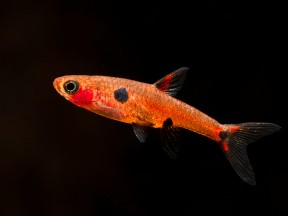

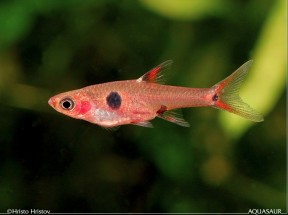
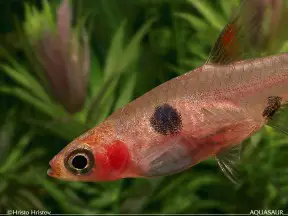


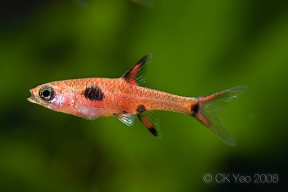



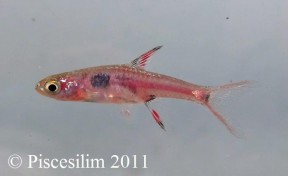
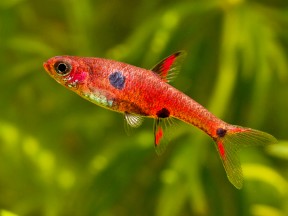


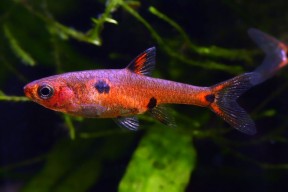


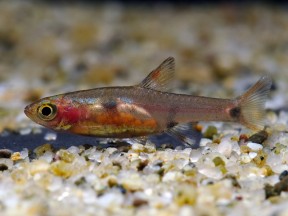

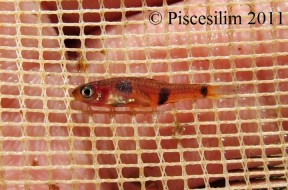

November 26th, 2013 at 7:51 am
I like this boraras!!!
May 27th, 2016 at 7:38 am
An excellent video displaying Indonesian specimens from of Boraras Maculatus in their natural habitat on Singkep Island. https://www.youtube.com/watch?v=4HZpzbti4q0
It is very interesting to note that in this video they move with a number of fish significantly larger than themselves in not at all slow moving or still water.
Lots of algae, lots of leaf litter.